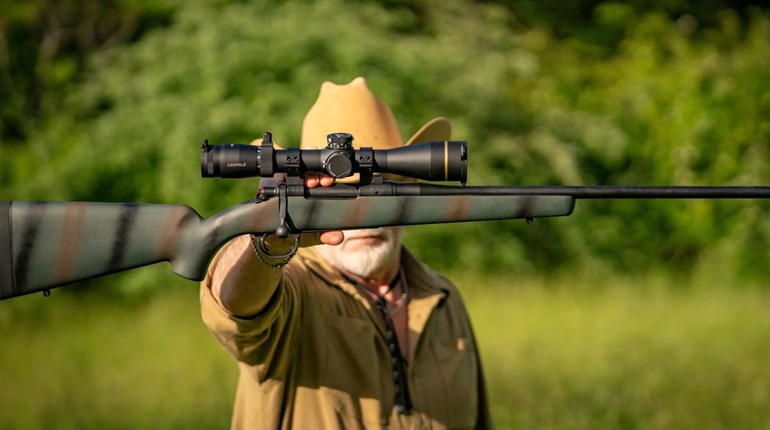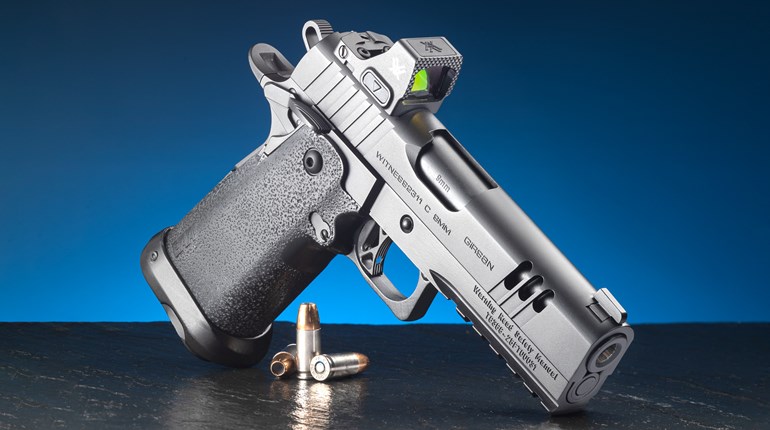
In 2017, Wilson Combat introduced the EDC X9. I was captivated by this pistol because I felt it represented a near-perfect amalgamation of the best of what the 1911, Browning Hi Power and Glock G19 had to offer. In early 2019, the EDC X9L was added to the EDC line, and now Wilson Combat has released the EDC X9S. If not one of the best pistols of any make or model for everyday carry, this newest pistol is without question the best out of the EDC line for that purpose.
According to Bill Wilson, “The EDC X9S, like the EDC X9L 5-inch, is basically an evolution of the basic [EDC] platform. Our main goal was to design a top-quality, 10+1- capacity 1911ish pistol that was the same basic size as a Smith & Wesson M&P Shield for deep concealment.” At first look, the EDC X9S appears to be just another compact 1911. And, since the 1911 is the gun Wilson’s fame was built on, what else would you expect? In truth, however, it is not. The EDC X9S is a metal-frame, semi-automatic pistol that mostly resembles a 1911.
All EDC pistols are built on an alloy frame and accept double-stack 9 mm magazines made by Mec-Gar. The EDC X9 uses a 15-round version derived from (but not identical to) a Walther PPQ, the EDC X9L uses an adapted 18-round Beretta 92 magazine (but again, not a standard 92 magazine) and the EDC X9S uses a derivative of the 10-round SIG Sauer P226/228 magazine (and once more, the SIG mags won’t work in the Wilson Combat gun). The trigger, magazine release, hammer, thumb safety, ejector and tilting-barrel recoil system are distinctly 1911 in style, but EDC pistols lack a grip safety. The backstrap, which houses the mainspring, is hinged at the top rear of the frame. When released (by inserting a punch into the hole in the bottom of the backstrap) the backstrap pivots away from the grip.
The 3-inch, coned and fluted barrel on the EDC X9S is ramped. There’s no barrel bushing, but there is a bushing holding the guided, dual recoil springs in place. The slide of the EDC X9S is removed just as with any 1911, but after the recoil spring is removed, the recoil-spring bushing slips out from the rear of the slide and the barrel is eased out from the front. Also, unlike with traditional 1911s, the extractor on all EDC pistols is external and user serviceable.
The grip frame on the EDC X9S is sculpted with Wilson Combat’s X-Tac treatment. These large and deep, angled grooves create a diamond pattern on the frontstrap and backstrap that provides a comfortable, secure grip. A similar pattern also replaces the common 1911 grasping grooves at the rear of the slide. Unlike the EDC X9 and EDC X9L, the EDC X9S does not have grip panels. Instead, the sides of the grip are flat and integral to the alloy frame. They’re also textured with a combination of the Wilson Combat Starburst and a muted
version of the X-Tac pattern.

Size
Typically, there are eight different measurements to determine pistol size. Based on these measurements, pistols generally fall into as many as five classifications; large, service, compact, subcompact and ultra-compact. This is probably an overcomplication—pistol size is mostly relative to the hand that will hold it and the body it must be carried on. With pistols like the 9.6-ounce, 2.75-inch-barreled Ruger LCP clearly representing the ultra-compact class, the new Wilson EDC X9S would best be described as a compact or—according to Wilson—a subcompact pistol.
To give you an idea of the actual size of the EDC X9S, comparison to a pistol with the same capacity most are moderately familiar with—the Glock G26—makes sense. If you total and compare all eight measurements between the G26 and the EDC X9S, they are essentially the same size; the point being, the EDC X9S should be in the same size classification as the G26, whatever name that might be.

Weight
For an everyday-carry gun, weight matters. But the weight that matters is not that of the pistol, it’s the weight of the fully loaded pistol. (Irrational would be the kindest way to describe someone carrying around an unloaded handgun because it’s lighter.) Without the magazine, the EDC X9S weighs 22.8 ounces. An empty magazine weighs 2.8 ounces, and a fully loaded magazine with 10 rounds of 115-grain ammunition weighs 6.9 ounces. Add an extra round for the chamber, and the fully loaded weight of the EDC X9S is 30.2 ounces.
For its compact size, that’s not light. Again, as a comparison, the EDC X9S is 4 ounces—a quarter-pound—heavier than a fully loaded G26. This quarter pound is kind of a big deal in two ways. Obviously, it will tug on your belt about 16 percent more, but the other way this additional weight matters has nothing to do with carrying the pistol; it has to do with shooting it.

Controllability
The EDC X9S’ additional weight is located forward of the trigger on the frame and the pistol’s slide actually weighs 2 ounces less than a G26’s. This means the part of the gun you hold weighs 6 ounces more. This translates to a pistol that’s easier to control during recoil. When shooting the EDC X9S, this is blatantly obvious; it seems like it was made to hammer a target.
My standard defensive-handgun test/comparison is the Forty-Five Drill. It requires drawing from concealment and firing five shots into a 5-inch circle at 5 yards, in less than 5 seconds. I’ve conducted this drill so many times, with so many handguns, it’s an ideal way for me to evaluate defensive handguns. My score for five runs on the Forty-Five Drill with the EDC X9S was 79.13, with an average time of 3.37 seconds. I tried to complete a few runs in less than 3 seconds, and did, but I also dropped one shot outside the 5-inch circle every time.
My best ever five-run score on this drill was with my lightweight Browning Hi Power at 83.59. My second best, at 80.74, was fired with the original EDC X9. With the G26—the pistol used for comparison throughout this review—my score was 74.45, with an average time of 3.51. For me, therefore, the EDC X9S was 4-percent faster and arguably 6-percent more efficient than the G26, and damn near identical to its larger brother, the EDC X9. Now, don’t assume that just since I’m not a Glock fanboy I’m not Glock proficient. I carried a G22 and G27 for almost 13 years while on duty and even won a Glock Match.
What I think this exercise clearly reflects is the importance of slide-to-frame weight with regard to shootability. The weight of a pistol matters, but what really matters is where on the pistol that weight is located.
The Trigger
Remarkably, the reset on the EDC X9S’ trigger measured only .026 inch; that’s thumbnail thin. The average reset on a Glock trigger is three to four times that long. Combined with a pull weight of 3.5 pounds and a break crisper than a tortilla chip with too much dip on it, that’s nothing short of extraordinary.
Bill Wilson told me, “The X9 trigger mechanism design allows us to achieve a short reset.” But, he also said he felt that only really mattered to Internet experts. Until shooting the EDC X9S, I would have agreed. However, I’m convinced the EDC X9S’ great trigger with such a short reset, in conjunction with its uniquely smooth, fast and light recoil impulse, is what allowed me to shoot it—for all practical purposes—as well as the larger, 4-inch-barreled EDC X9. Maybe it’s just me, or maybe I’ve become an “Internet expert.”

Precision
I don’t get wrapped up in precision when it comes to defensive handguns. Every defensive handgun I’ve tested over the years has delivered more than sufficient precision to serve the role for which it was intended. I used to conduct group testing from a bench, but realized it was a waste of time—these guns are not intended to be shot from a bench; they’re made to save lives during a dynamic confrontation. If you and your defensive handgun can put five shots inside a snuff can while shooting from the offhand position at 10 yards, it’s more than capable of getting the job done.
With the EDC X9S, I tested three loads by slow firing five, five-shot groups from the standing offhand position at 10 yards. The average for all groups combined was 1.83 inches. With a fighting pistol outfitted with fixed sights, what’s more important than group size is if the sights point to where the bullets go. I found the point-of-impact at 10 yards to perfectly match point-of-aim.
 Reliability
Reliability
Of course, with defensive handguns, reliability is paramount. No matter how much you like a pistol, how pretty it is or how much it costs, if it does not go bang every time, it is not a pistol for personal protection.
I fired 500 rounds through the EDC X9S, testing 10 different loads with bullet weights ranging from 115 to 147 grains. Bullet styles included FMJ, synthetic-jacketed lead and conventional hollowpoints. Only 25 rounds were fired from the bench, the rest were shot during various defensive drills. Some drills were fired with both hands, some with only the strong hand and some weak-hand-only.
There were no stoppages. Will this pistol work with your favorite load? One can only speculate, but with results like these, there’s an extremely high probability it will run about anything you shove in it.
When it comes to concealed carry, the smaller and lighter the handgun, the more likely it is to be carried every day. On the other hand, the smaller and lighter a handgun, the less likely you’ll be able to shoot it fast and accurately. Finding that balance of weight, size, shootability and power is what finding the perfect everyday-carry gun is all about. However, that ideal balance will be slightly different for everyone.
 With the EDC X9S, Wilson Combat has done a wonderful job of finding a balance I’d rate as universal. It should agree splendidly with almost every shooter. And, they’ve found this balance on an ultra-reliable, single-action, subcompact platform, without the use of polymer. As icing on the cake, they’ve incorporated the best trigger I’ve ever pulled on a fighting handgun, period.
With the EDC X9S, Wilson Combat has done a wonderful job of finding a balance I’d rate as universal. It should agree splendidly with almost every shooter. And, they’ve found this balance on an ultra-reliable, single-action, subcompact platform, without the use of polymer. As icing on the cake, they’ve incorporated the best trigger I’ve ever pulled on a fighting handgun, period.
There’s a reason why Bill Wilson is regarded by many—including me—as the best pistolsmith in the world. My advice is, if you see an EDC X9S lurking under the glass at your favorite firearm emporium, do not pick it up unless your wallet can stand the pain. Once in hand, the EDC X9S is damned hard to let go of. It is an ideal personal-protection firearm, and it may be the best justification for a credit card I’ve ever seen.








































